A Highly Sensitive NiO Flexible Temperature Sensor Prepared by Low-Temperature Sintering Electrohydrodynamic Direct Writing
Abstract
:1. Introduction
2. Materials and Methods
2.1. Experimental Materials
2.2. Experimental Apparatus
2.3. Preparation of NiO Flexible Temperature Sensor
3. Results and Discussion
3.1. Fiber Characterization
3.2. Performance of NiO Flexible Temperature Sensor
4. Conclusions
Author Contributions
Funding
Data Availability Statement
Conflicts of Interest
References
- Jiang, J.; Chen, X.; Mei, Z.; Chen, H.; Chen, J.; Wang, X.; Li, S.; Zhang, R.; Zheng, G.; Li, W. Review of droplet printing technologies for flexible electronic devices: Materials, control, and applications. Micromachines 2024, 15, 333. [Google Scholar] [CrossRef] [PubMed]
- Yan, Z.-Y.; Liu, J.-Y.; Niu, J.-R. Research of a novel ag temperature sensor based on fabric substrate fabricated by magnetron sputtering. Materials 2021, 14, 6014. [Google Scholar] [CrossRef] [PubMed]
- Kuzubasoglu, B.A.; Bahadir, S.K. Flexible temperature sensors: A review. Sens. Actuators A Phys. 2020, 315, 112282. [Google Scholar] [CrossRef]
- Shepelin, N.A.; Tehrani, Z.P.; Ohannessian, N.; Schneider, C.W.; Pergolesi, D.; Lippert, T. A practical guide to pulsed laser deposition. Chem. Soc. Rev. 2023, 52, 2294–2321. [Google Scholar] [CrossRef]
- Zheng, G.; Jiang, J.; Wang, X.; Li, W.; Yu, Z.; Lin, L. High-aspect-ratio three-dimensional electrospinning via a tip guiding electrode. Mater. Des. 2021, 198, 109304. [Google Scholar] [CrossRef]
- Zhang, Z.; Liu, Z.; Lei, J.; Chen, L.; Li, L.; Zhao, N.; Fang, X.; Ruan, Y.; Tian, B.; Zhao, L. Flexible thin film thermocouples: From structure, material, fabrication to application. iScience 2023, 26, 107303. [Google Scholar] [CrossRef]
- Yu, J.; Han, W.; Suleiman, A.A.; Han, S.; Miao, N.; Ling, F.C.-C. Recent advances on pulsed laser deposition of large-scale thin films. Small Methods 2023, 8, 2301282. [Google Scholar] [CrossRef]
- Depla, D. The measurement and impact of negative oxygen ions during reactive sputter deposition. Crit. Rev. Solid State Mater. Sci. 2023, 27, 718–753. [Google Scholar] [CrossRef]
- Shin, J.; Jeong, B.; Kim, J.; Nam, V.B.; Yoon, Y.; Jung, J.; Hong, S.; Lee, H.; Eom, H.; Yeo, J.; et al. Sensitive wearable temperature sensor with seamless monolithic integration. Adv. Mater. 2020, 32, e1905527. [Google Scholar] [CrossRef]
- Chai, J.; Wang, X.; Li, X.; Wu, G.; Zhao, Y.; Nan, X.; Xue, C.; Gao, L.; Zheng, G. A dual-mode pressure and temperature sensor. Micromachines 2024, 15, 179. [Google Scholar] [CrossRef]
- Lu, Y.; Zhang, H.; Zhao, Y.; Liu, H.; Nie, Z.; Xu, F.; Zhu, J.; Huang, W. Robust fiber-shaped flexible temperature sensors for safety monitoring with ultrahigh sensitivity. Adv. Mater. 2024, 36, e2310613. [Google Scholar] [CrossRef] [PubMed]
- Feteira, A. Negative temperature coefficient resistance (NTCR) ceramic thermistors: An industrial perspective. J. Am. Ceram. Soc. 2009, 92, 967–983. [Google Scholar] [CrossRef]
- Pai, S.H.S.; Mondal, A.; Ramya Barathy, T.; Ajitha, B.; James Jebaseelan Samuel, E.; Ashok Kumar Reddy, Y. Effect of calcination temperature on NiO for hydrogen gas sensor performance. Int. J. Hydrogen Energy 2024, 50, 928–941. [Google Scholar] [CrossRef]
- Nam, V.B.; Lee, D. Evaluation of Ni-based flexible resistance temperature detectors fabricated by laser digital pattering. Nanomaterials 2021, 11, 576. [Google Scholar] [CrossRef] [PubMed]
- An, D.; Chen, L.; Liang, Y.; Hou, J.; Chen, J. Defect-containing metal-organic framework materials for sensor applications. J. Mater. Chem. A 2024, 12, 38–58. [Google Scholar] [CrossRef]
- Huang, Y.; Bu, N.; Duan, Y.; Pan, Y.; Liu, H.; Yin, Z.; Xiong, Y. Electrohydrodynamic direct-writing. Nanoscale 2013, 5, 12007–12017. [Google Scholar] [CrossRef]
- Zheng, G.; Li, W.; Wang, X.; Wu, D.; Sun, D.; Lin, L. Precision deposition of a nanofibre by near-field electrospinning. J. Phys. D Appl. Phys. 2010, 43, 415501. [Google Scholar] [CrossRef]
- Guo, Y.; Wang, X.; Shen, Y.; Dong, K.; Shen, L.; Alzalab, A.A.A. Research progress, models and simulation of electrospinning technology: A review. J. Mater. Sci. 2022, 57, 58–104. [Google Scholar] [CrossRef]
- Gong, X.; Huang, K.; Wu, Y.-H.; Zhang, X.-S. Recent progress on screen-printed flexible sensors for human health monitoring. Sens. Actuators A Phys. 2022, 345, 113821. [Google Scholar] [CrossRef]
- Kang, G.; Zhong, Y.; Du, X.; Shao, Z.; Jiang, J.; Wang, X.; Li, W.; Guo, S.; Gao, L.; Fang, Z.; et al. Low-temperature sintering of silver-ammonia complex organic composite ink shows high conductivity for humidity sensors. Mater. Des. 2023, 234, 112374. [Google Scholar] [CrossRef]
- Du, X.; Zhong, Y.; Kang, G.; Jiang, J.; Wang, X.; Li, W.; Zheng, G. Low-temperature self-stacking ink for electrohydrodynamic direct writing. ACS Appl. Polym. Mater. 2023, 5, 5314–5321. [Google Scholar] [CrossRef]
- Fourmont, P.; Bai, Y.; Fortier, F.-X.; Cloutier, S.G. Graphene-enhanced screen-printed BiFeO3-based thermistors. ACS Appl. Electron. Mater. 2022, 4, 5905–5913. [Google Scholar] [CrossRef]
- Trung, T.Q.; Le, H.S.; Dang, T.M.L.; Ju, S.; Park, S.Y.; Lee, N.-E. Freestanding, fiber-based, wearable temperature sensor with tunable thermal index for healthcare monitoring. Adv. Healthc. Mater. 2018, 7, 1800074. [Google Scholar] [CrossRef] [PubMed]
- Nuthalapati, S.; Shirhatti, V.; Kedambaimoole, V.; Takao, H.; Nayak, M.; Rajanna, K. Highly sensitive flexible strain and temperature sensors using solution processed graphene palladium nanocomposite. Sens. Actuators A Phys. 2022, 334, 113314. [Google Scholar] [CrossRef]
- Hardian, A.; Greshela, S.; Yuliana, T.; Budiman, S.; Murniati, A.; Kusumaningtyas, V.; Syarif, D. Cu-Mn Co-Doped NiFe2O4 Based Thick Ceramic Film as Negative Temperature Coefficient Thermistors. In IOP Conference Series: Earth and Environmental Science; IOP Publishing: Bristol, UK, 2021; p. 012017. [Google Scholar]
- Gao, C.; Li, Z.; Yang, L.; Peng, D.; Zhang, H. Investigation of electrical and aging properties of bi-modified (Zn0.4Ni0.6)1−xNaxO ceramic thermistors. J. Eur. Ceram. Soc. 2021, 41, 4160–4166. [Google Scholar] [CrossRef]
- Georgas, M.; Selinis, P.; Zardalidis, G.; Farmakis, F. Temperature sensors by inkjet printing compatible with flexible substrates: A review. IEEE Sens. J. 2022, 23, 21–33. [Google Scholar] [CrossRef]
- Barmpakos, D.; Kaltsas, G. A review on humidity, temperature and strain printed sensors—Current trends and future perspectives. Sensors 2021, 21, 739. [Google Scholar] [CrossRef]
- Wadhwa, A.; Benavides-Guerrero, J.; Gratuze, M.; Bolduc, M.; Cloutier, S.G. All screen printed and flexible silicon carbide ntc thermistors for temperature sensing applications. Materials 2024, 17, 2489. [Google Scholar] [CrossRef] [PubMed]
- Turkani, V.S.; Maddipatla, D.; Narakathu, B.B.; Bazuin, B.J.; Atashbar, M.Z. A carbon nanotube based ntc thermistor using additive print manufacturing processes. Sens. Actuators A Phys. 2018, 279, 1–9. [Google Scholar] [CrossRef]
- Barmpakos, D.; Belessi, V.; Schelwald, R.; Kaltsas, G. Evaluation of inkjet-printed reduced and functionalized water-dispersible graphene oxide and graphene on polymer substrate—Application to printed temperature sensors. Nanomaterials 2021, 11, 2025. [Google Scholar] [CrossRef] [PubMed]
- Umar, M.; Irani, F.S.; Mirbakht, S.S.; Yapici, M.K. Contact-based and proximally thermosensitive few-layer graphene Ntc thermistors with highly fast switching behavior. Adv. Electron. Mater. 2024, 10, 2300723. [Google Scholar] [CrossRef]
- Xiao, Y.; Jiang, S.; Li, Y.; Zhang, W. Screen-printed flexible negative temperature coefficient temperature sensor based on polyvinyl chloride/carbon black composites. Smart Mater. Struct. 2021, 30, 025035. [Google Scholar] [CrossRef]
- Barmpakos, D.; Tsamis, C.; Kaltsas, G. Multi-parameter paper sensor fabricated by inkjet-printed silver nanoparticle ink and PEDOT:PSS. Microelectron. Eng. 2020, 225, 111266. [Google Scholar] [CrossRef]
- Kuzubasoglu, B.A.; Sayar, E.; Cochrane, C.; Koncar, V.; Bahadir, S.K. Wearable temperature sensor for human body temperature detection. J. Mater. Sci. Mater. Electron. 2021, 32, 4784–4797. [Google Scholar] [CrossRef]
- Martins, B.; Patacas, C.; Cavaleiro, A.; Faia, P.; Bondarchuk, O.; Fernandes, F. Can ZrAlN thin films be used as thermistor sensors for temperature assessment? J. Sci. Adv. Mater. Devices 2024, 9, 100676. [Google Scholar] [CrossRef]
- Hsiao, F.-R.; Liao, Y.-C. Printed micro-sensors for simultaneous temperature and humidity detection. IEEE Sens. J. 2018, 18, 6788–6793. [Google Scholar] [CrossRef]

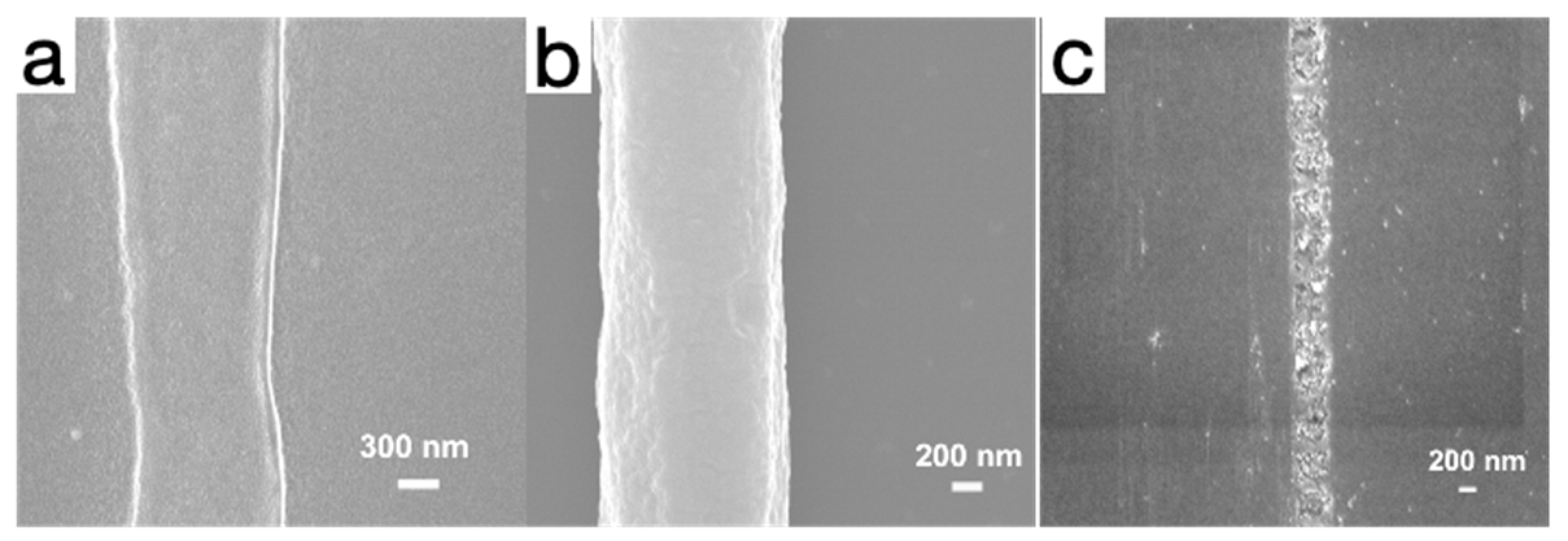
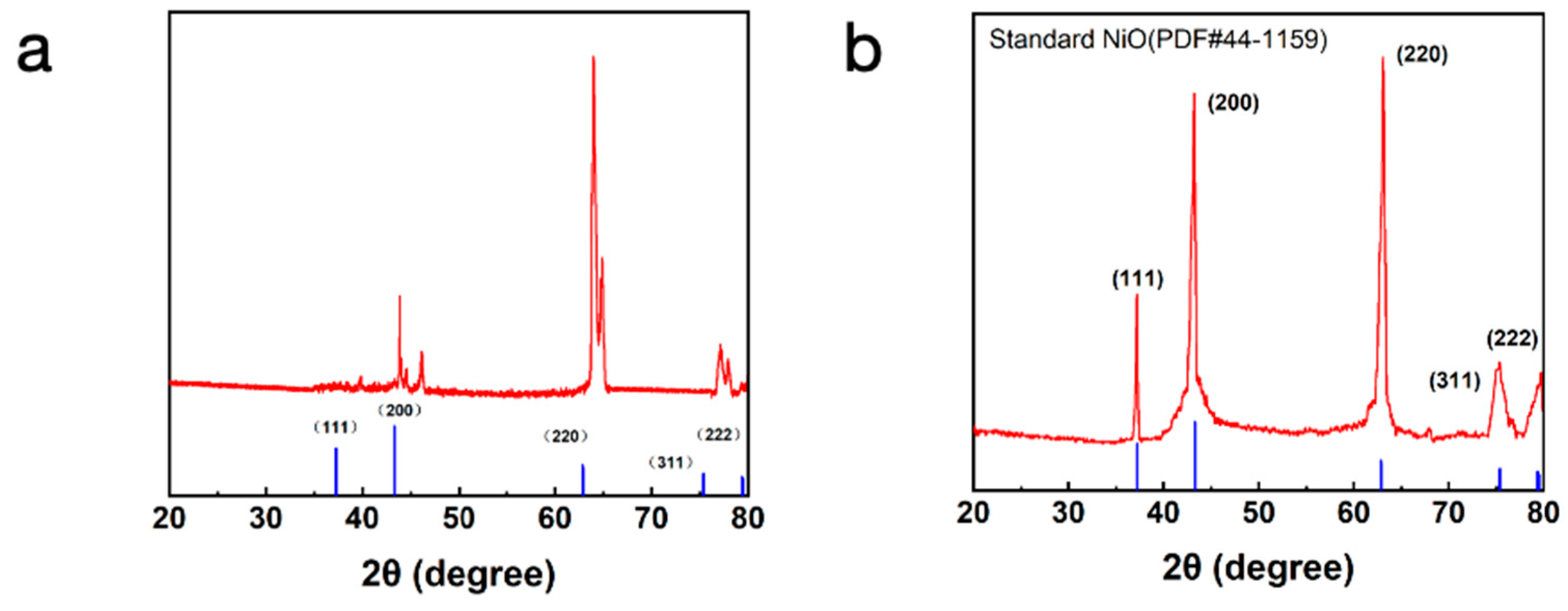
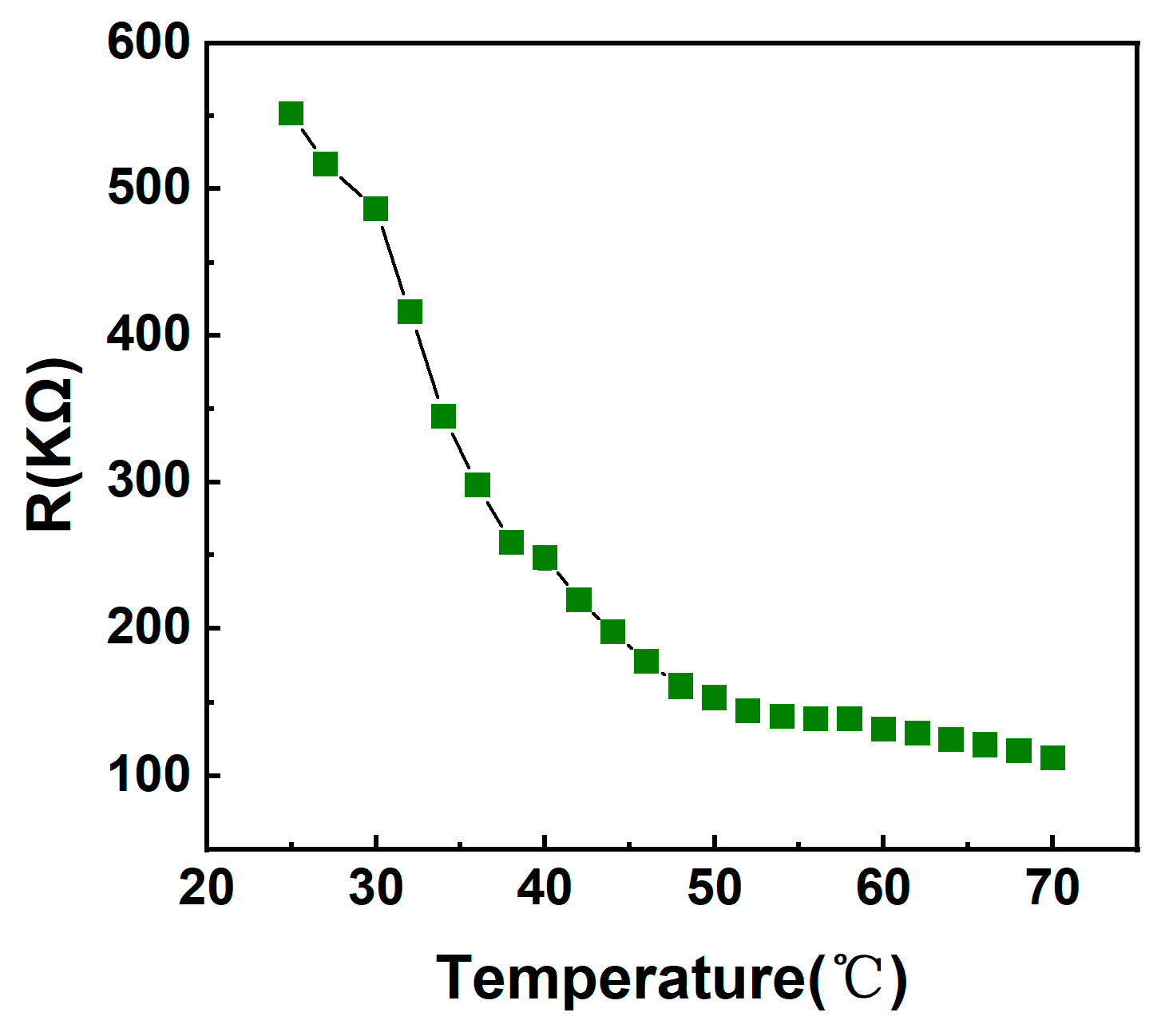

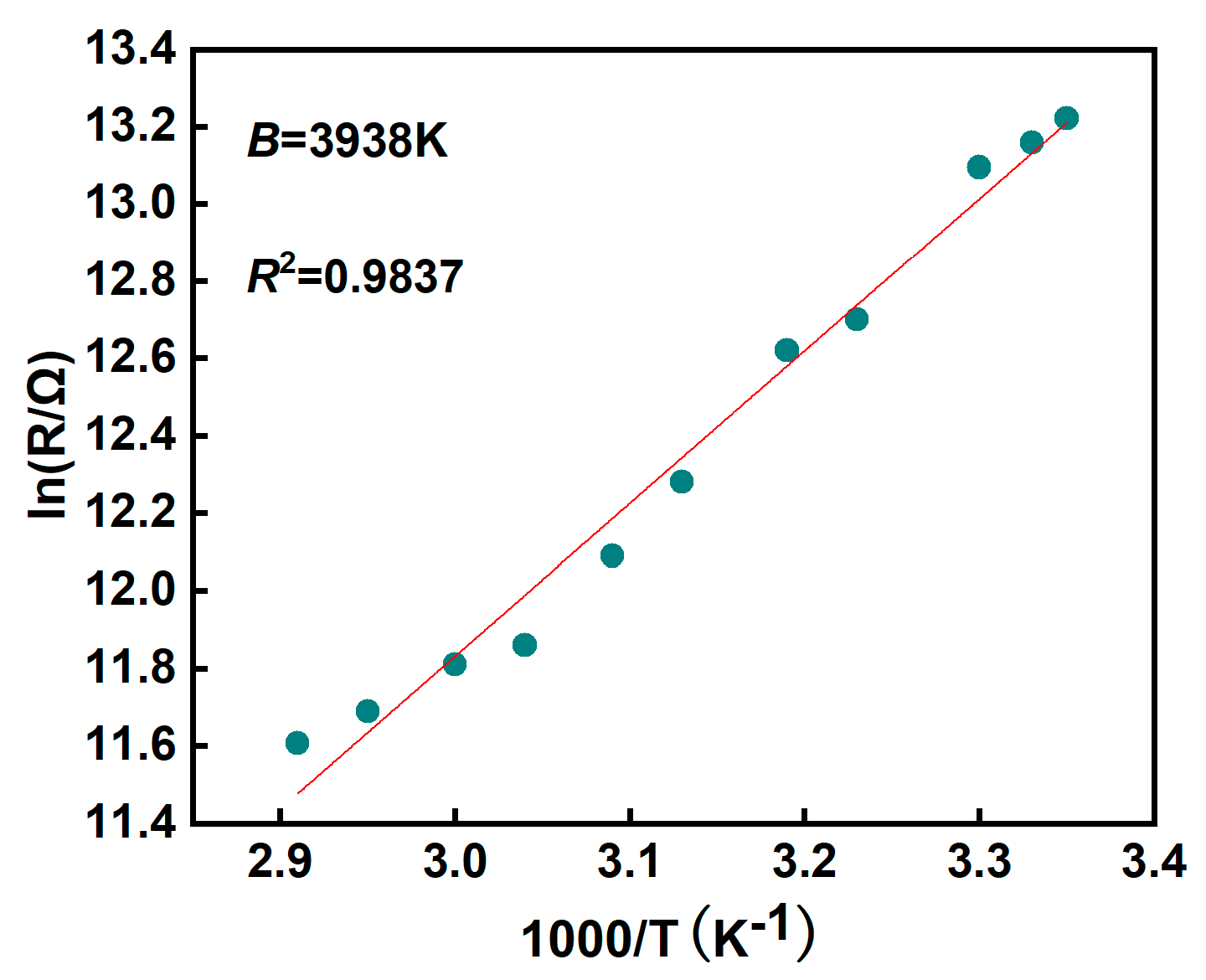
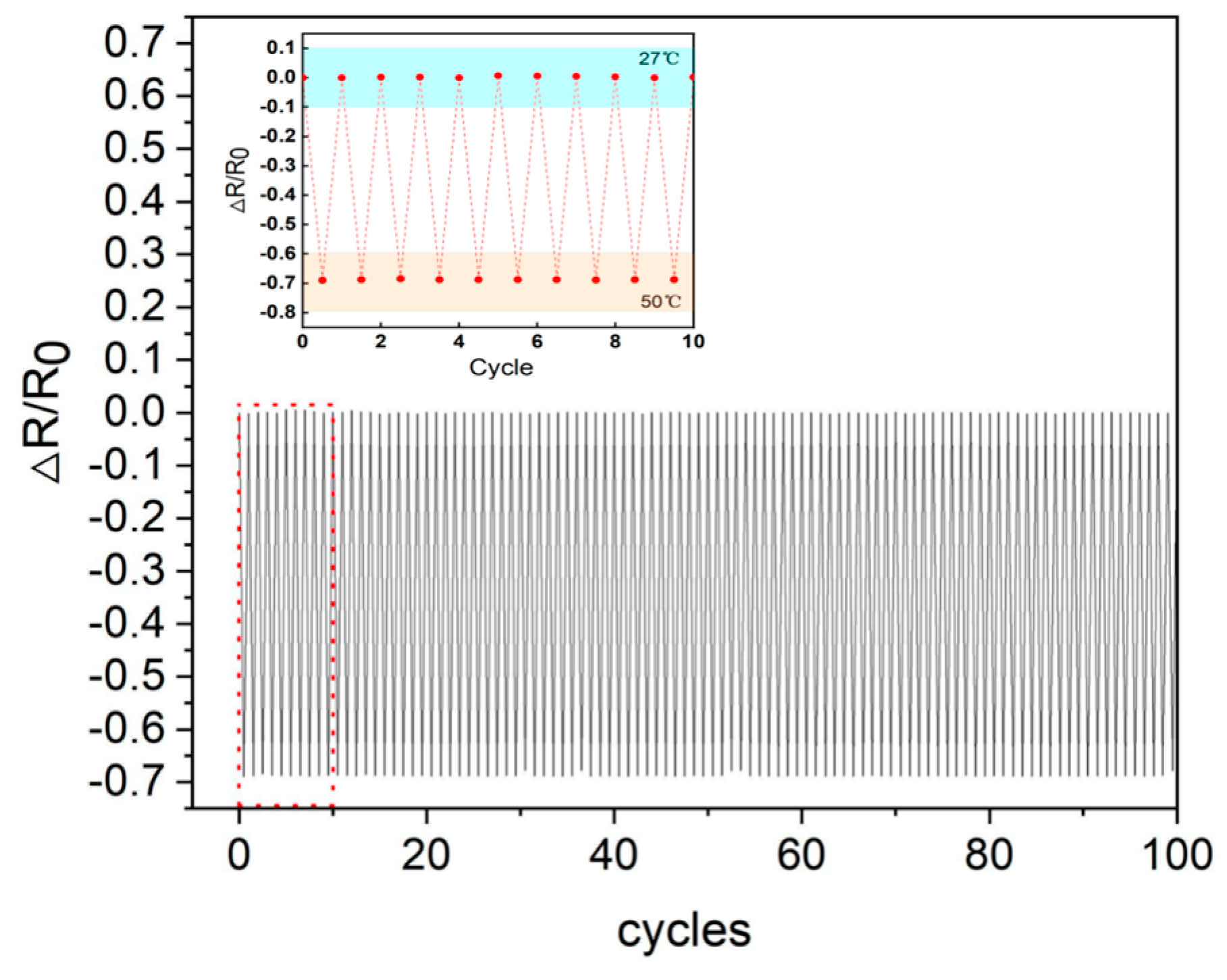
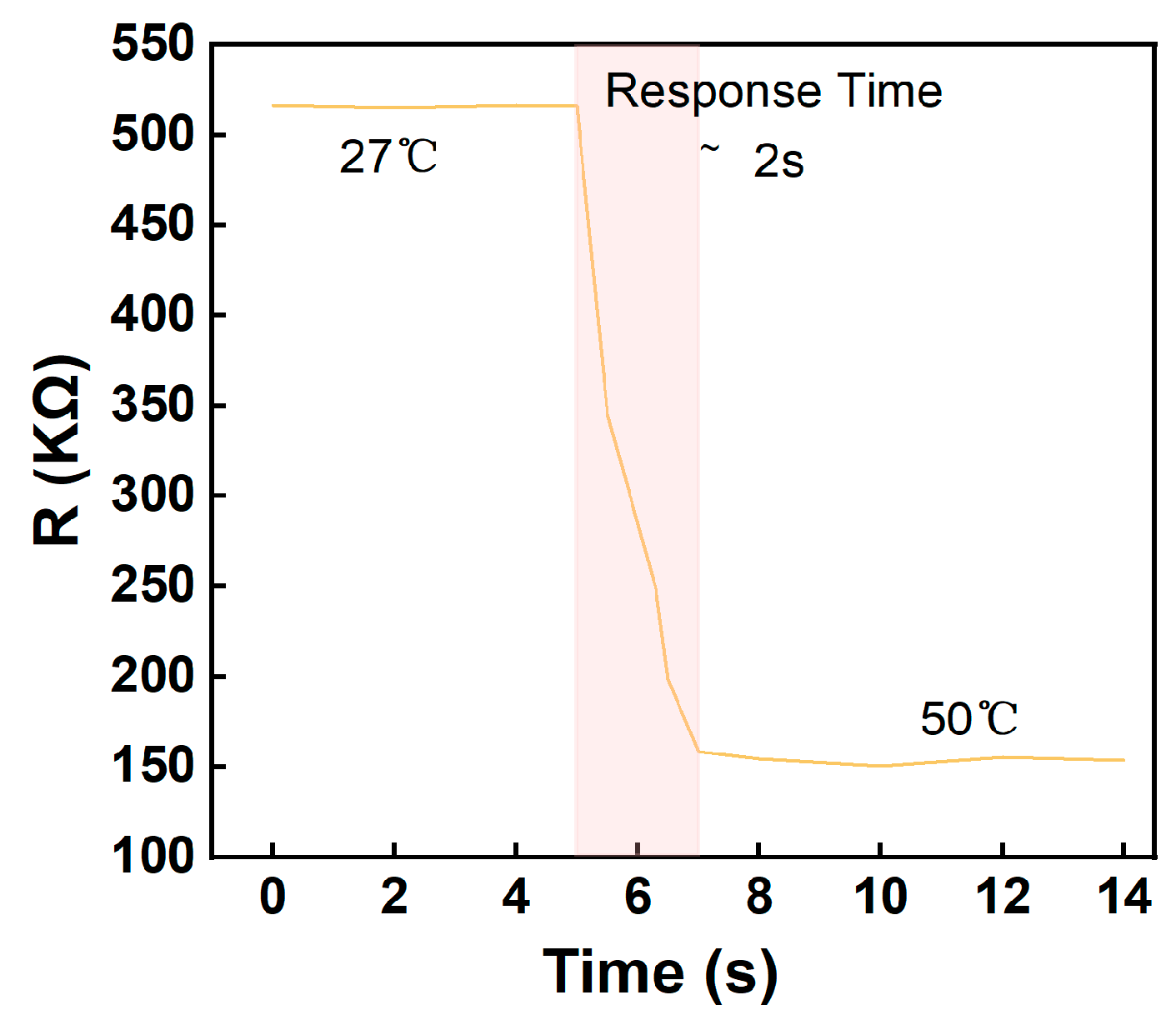
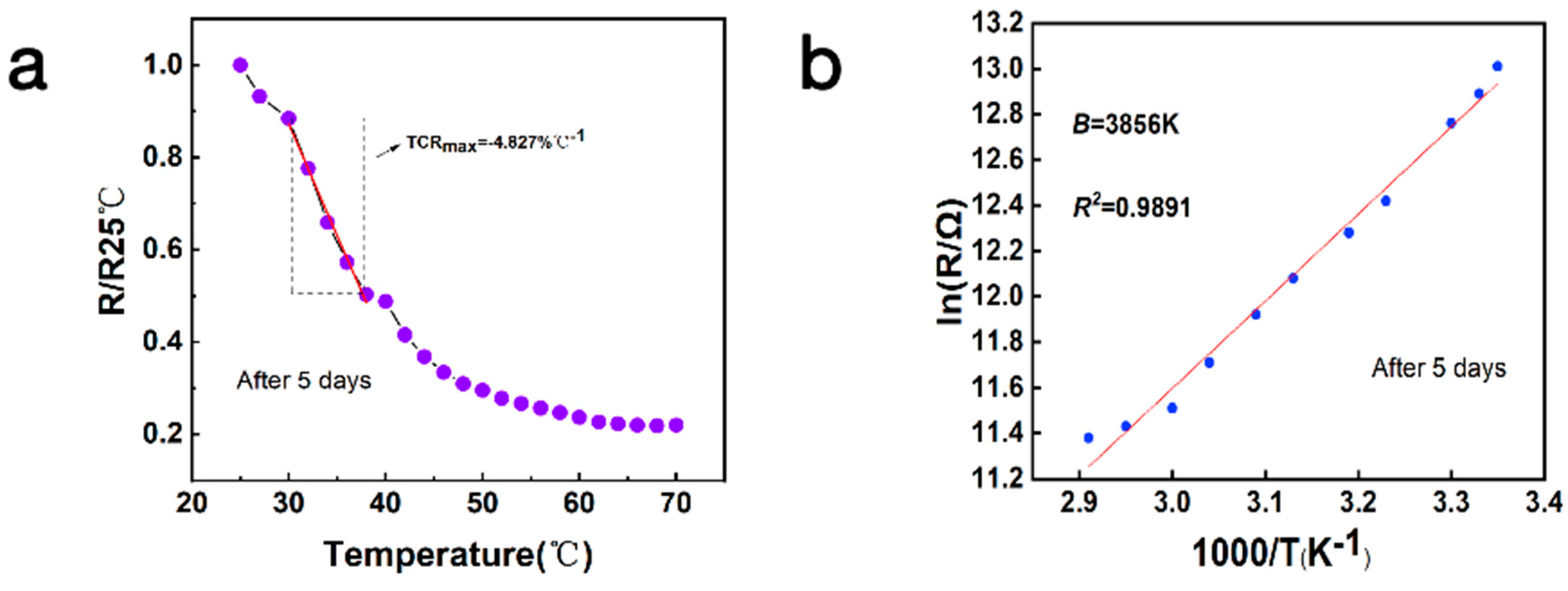

| Materials | Process | B-Index (K) | Sensitivity (%/°C) | Temperature Range (°C) | Ref. |
|---|---|---|---|---|---|
| SiC | Screen printing | 502 | −0.556 | 25–170 | [29] |
| Carbon nanotubes | Screen printing | – | −0.4 | −40–100 | [30] |
| f-rGO | Inkjet printing | – | −1.64 | 25–83 | [31] |
| Graphene | CVD | 100 | −0.12 | −20–100 | [32] |
| Polyvinyl chloride/carbon black | Screen printing | – | −0.148 | 18–44 | [33] |
| Ag & PEDOT: PSS | Inkjet printing | – | −1.39 | 25–45 | [34] |
| MWCNTs | Inkjet printing | 1135 | −1.04 | 25–50 | [35] |
| BiFeO3 + 3.5 wt% graphene | Screen printing | – | −0.961 | 25–170 | [22] |
| ZrAlN | Sputtering | 3000 | – | 25–100 | [36] |
| NiO/CBNPs | 3D Printing | – | −0.111 | 20–70 | [37] |
| NiO | Electrohydrodynamic direct writing | 3938 | −5.194 | 25–70 | This work |
Disclaimer/Publisher’s Note: The statements, opinions and data contained in all publications are solely those of the individual author(s) and contributor(s) and not of MDPI and/or the editor(s). MDPI and/or the editor(s) disclaim responsibility for any injury to people or property resulting from any ideas, methods, instructions or products referred to in the content. |
© 2024 by the authors. Licensee MDPI, Basel, Switzerland. This article is an open access article distributed under the terms and conditions of the Creative Commons Attribution (CC BY) license (https://creativecommons.org/licenses/by/4.0/).
Share and Cite
Wang, T.; Du, X.; Zheng, G.; Xue, Z.; Zhang, J.; Chen, H.; Gao, L.; Li, W.; Wang, X.; Liu, Y.; et al. A Highly Sensitive NiO Flexible Temperature Sensor Prepared by Low-Temperature Sintering Electrohydrodynamic Direct Writing. Micromachines 2024, 15, 1113. https://doi.org/10.3390/mi15091113
Wang T, Du X, Zheng G, Xue Z, Zhang J, Chen H, Gao L, Li W, Wang X, Liu Y, et al. A Highly Sensitive NiO Flexible Temperature Sensor Prepared by Low-Temperature Sintering Electrohydrodynamic Direct Writing. Micromachines. 2024; 15(9):1113. https://doi.org/10.3390/mi15091113
Chicago/Turabian StyleWang, Ting, Xianruo Du, Gaofeng Zheng, Zhiyuan Xue, Junlin Zhang, Huatan Chen, Libo Gao, Wenwang Li, Xiang Wang, Yifang Liu, and et al. 2024. "A Highly Sensitive NiO Flexible Temperature Sensor Prepared by Low-Temperature Sintering Electrohydrodynamic Direct Writing" Micromachines 15, no. 9: 1113. https://doi.org/10.3390/mi15091113
APA StyleWang, T., Du, X., Zheng, G., Xue, Z., Zhang, J., Chen, H., Gao, L., Li, W., Wang, X., Liu, Y., & Jiang, J. (2024). A Highly Sensitive NiO Flexible Temperature Sensor Prepared by Low-Temperature Sintering Electrohydrodynamic Direct Writing. Micromachines, 15(9), 1113. https://doi.org/10.3390/mi15091113









